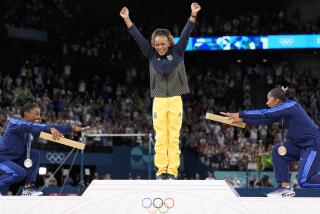Finally, a Chance to Celebrate
- Share via
SANTO DOMINGO, Dominican Republic — As he drove up the road to the Olympic village Thursday evening, USOC press officer Cecil Bleiker did a double take.
“I swear,” he said as he looked at a freshly paved exit, which wound its way up to the parking area, “that wasn’t here yesterday.”
No surprise. Three months ago, it appeared this country, which had committed itself back in 1998 to be host of the XIV Pan American Games, was poised on the brink of a national embarrassment, having vastly underestimated the task it had undertaken.
Proposed sites remained undeveloped, deadlines were not met and promises were not kept. Mario Vasquez Rana, head of the Pan American Sports Organization, became a heavy critic of the Dominican effort. Plans were even floated to shift events to Florida.
“After I visited here, I was ready to throw in the towel,” said Roland Betts, the chef de mission for the U.S. delegation. “It seemed like [the Pan Am Games] would never happen. It was a never-ending nightmare.”
The nightmare turned into a dream evening Friday as the Games, the largest ever with more than 7,000 athletes from 42 nations competing in 38 sports and 288 events, began with a joyous opening ceremony at Juan Pablo Duarte Olympic Stadium.
Precisely at 7 p.m., right on time, colorful dancers took the field just as was envisioned five years ago. Paid attendance was 18,000, and, combined with the athletes and performers, the 35,000-seat stadium was filled.
Two of this country’s most celebrated baseball heroes, past and present, handled the last leg of the torch-lighting. Boston Red Sox pitcher Pedro Martinez, who pitched Thursday, carried the torch on the next-to-last leg before handing it off to Hall of Famer Juan Marichal. Marichal lighted a caldron on the field below a larger caldron positioned at the stadium’s rim. Then as Luis Pujols, nephew of the San Francisco first base coach of the same name, took a swing at a ball, a laser beam from the roof of the press box, located on the opposite side, then shot across the dark, cloudless sky, igniting the caldron at the top as fireworks exploded and the crowd began a wild but peaceful celebration that spread into the streets and well into the night.
The only sour note at the ceremony was the appearance of Rana, who was booed by the crowd for expressing doubt that this night would occur.
Looking on were 700 U.S. athletes, part of a 1,200-person delegation. That is more athletes than will be in the U.S. delegation at next year’s Olympics because there are seven additional sports -- bowling, karate, jai alai, racquetball, roller sports, squash and water skiing -- that are not included in the Olympics. The U.S. is not fielding teams for jai alai or soccer.
So how did all this come together so quickly? How did roads appear overnight and venues spring up?
Betts credits Hipolito Mejia, the Dominican president.
“He was determined to make these Games happen,” Betts said. “He met twice with President Bush, who really encouraged him.”
And Mejia had a conversation with Betts.
“I told him three months ago,” said Betts, “that if he wanted to get this done, there could be no vacations, no days off and 15- to 20-hour workdays.”
A country of about 8 million, the Dominican Republic shares a body of land with Haiti and is only a ferry ride away from Puerto Rico to the east.
It has long been known as a hotbed of baseball, one rare diamond gem after another being uncovered on these shores from pitchers Martinez and Marichal to hitters Sammy Sosa, Albert Pujols and Pedro Guerrero. The mother lode of talent has been so great, the Dodgers built a baseball academy here, now merely one of many run by various big league clubs.
But the hope is that these Games will show the world that the Dominican Republic can be more than a baseball factory.
“This is a big, big deal for this country,” Betts said. “It’s a small country, not very wealthy, but very proud and determined to undertake this huge, huge responsibility.”
That determination has enabled it to come together in recent days. Work had not begun on a cafeteria for the Olympic village until about four months ago, but the facility was functional when the athletes arrived. Rolling blackouts across the country last week sparked violent protests and spurred fears that the Games would short-circuit, but government officials spent an additional $1 million to provide emergency generators at all sites.
Fears of terrorism have caused the government to employ a 7,000-member security team.
The cost of the Games is estimated at $150 million to $175 million, with speculation it might rise as high as $300 million. Those figures are in U.S. dollars, which means the cost to the Dominican economy is even more severe since the exchange rate has gone from 18-to-1 when the project began to as high as 44-to-1 before dipping to its current 31-to-1.
About four miles from the sports complex, police used tear gas to break up a march by hundreds of Dominicans protesting their government’s economic policies. No serious injuries were reported.
Still the work goes on. Heeding Betts’ advice, government officials have construction projects going 24 hours a day.
“If you drive back and forth between the Olympic village and [downtown Santo Domingo],” Betts said, “you see the landscaping improved every day, every trip.”
Associated Press contributed to this report.
More to Read
Go beyond the scoreboard
Get the latest on L.A.'s teams in the daily Sports Report newsletter.
You may occasionally receive promotional content from the Los Angeles Times.






